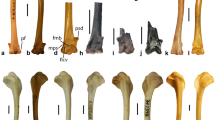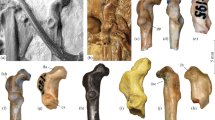Abstract
Exceptionally well-preserved new specimens of the Messelirrisoridae (Aves: Bucerotes), which show previously unknown features of the osteology and feathering of these tiny birds, are described from the Middle Eocene of Messel in Germany. Most notably in one of the new specimens the wing and tail feathers are excellently preserved and even show the former color pattern of the tail. A cream-colored substance in some specimens most likely constitutes fossilized uropygial gland waxes. For the first time, the phylogenetic affinities of the Messelirrisoridae are evaluated in a cladistic analysis, based on 122 characters and 34 extant and fossil taxa. The results of this analysis support the earlier hypothesis that Messelirrisoridae are stem lineage Upupiformes, i.e. the sister taxon of the clade including extant hoopoes (Upupidae) and woodhoopoes (Phoeniculidae). The analysis further supports sister group relationship between Bucerotes (Upupiformes + Bucerotidae [hornbills]) and Piciformes (woodpeckers and allies), although it is detailed that one of the recently proposed apomorphies of the clade (Bucerotes + Piciformes) is absent in the Messelirrisoridae.
Kurzfassung
Außergewöhnlich gut erhaltene neue Exemplare der Messelirrisoridae (Aves: Bucerotes) werden aus dem mittleren Eozän von Messel in Deutschland beschrieben und zeigen bisher unbekannte Details der Osteologie und Befiederung dieser kleinen Vögel. Insbesondere sind bei einem der neuen Exemplare die Flügel- und Schwanzfedern und sogar das ehemalige Farbmuster der Schwanzfedern ausgezeichnet erhalten. Eine beige Substanz in einigen Exemplaren stellt wahrscheinlich fossilisierte Bürzeldrüsensekrete dar. Zum ersten Mal werden die phylogenetischen Beziehungen der Messelirrisoridae in einer kladistischen Analyse untersucht, der 122 Merkmale und 34 rezente und fossile Taxa zugrunde liegen. Die Resultate dieser Analyse stützen die frühere Hypothese, dass Messelirrisoridae Stammgruppenvertreter der Upupiformes sind, d.h. die Schwestergruppe eines die rezenten Wiedehopfe (Upupidae) und Baumhopfe (Phoeniculidae) umfassenden Taxons. Die Analyse stützt darüber hinaus ein Schwestergruppenverhältnis zwischen Bucerotes (Upupiformes + Bucerotidae [Nashornvögel]) und Piciformes (Spechte und Verwandte), obgleich eine der vor kurzem diskutierten Apomorphien des Taxons (Bucerotes + Piciformes) den Messelirrisoridae fehlt.
Similar content being viewed by others
References
Baumel, J.J. &Witmer, L.M. 1993. Osteologia. — In:Baumel, J.J.;King, A.S.;Breazile, J.E.;Evans, H.E. &Vanden Berge, J.C., eds., Handbook of avian anatomy: Nomina Anatomica Avium. — Publications of the Nuttall Ornithological Club23: 45–132.
Burton, P.J.K. 1984. Anatomy and evolution of the feeding apparatus in the avian orders Coraciiformes and Piciformes. — Bulletin of the British Museum (Natural History) Zoological Series47: 331–443.
Cracraft, J.;Barker, F.K.;Braun, M.;Harshman, J.;Dyke, G.J.;Feinstein, J.;Stanley, S.;Cibois, A.;Schikler, P.;Beresford, P.;García-Moreno, J.;Sorenson, M.D.;Yuri, T. &Mindell, D.P. 2004. Phylogenetic relationships among modern birds (Neornithes): toward an avian tree of life. — In:Cracraft, J. &Donoghue, M., eds., Assembling the Tree of Life: 468–489, New York (Oxford University Press).
Craske, A.J. &Jefferies, R.P.S. 1989. A new mitrate from the Upper Ordovician of Norway, and a new approach to subdividing a plesion. — Palaeontology32: 69–99.
Ericson, P.G.P.;Irestedt, M. &Johansson, U. 2003. Evolution, biogeography, and patterns of diversification in passerine birds. — Journal of Avian Biology34: 3–15.
Espinosa de los Monteros, A. 2000. Higher-level Phylogeny of Trogoniformes. — Molecular Phylogenetics and Evolution14: 20–34.
Fain, M.G. &Houde, P. 2004. Parallel radiations in the primary clades of birds. — Evolution58: 2558–2573.
Fiedler, S. &Graw, M. 2003. Decomposition of buried corpses, with special reference to the formation of adipocere. — Naturwissenschaften90: 291–300.
Forbes, B.A. 1880. On the Anatomy ofLeptosoma discolor. — Proceedings of the Zoological Society of London1880: 465–475.
Franzen, J.L. 1985. Exceptional preservation of Eocene vertebrates in the lake deposit of Grube Messel. — Philosophical Transactions of the Royal Society, London (B)311: 181–186.
Gadow, H. 1893. Vögel. II. — Systematischer Theil. — In:Bronn, H.G., ed., Klassen und Ordnungen des Thier-Reichs, vol. 6 (4). — 304 p., Leipzig (C.F. Winter).
George, J.C. &Berger, A.J. 1966. Avian myology. — 500 p., New York (Academic Press).
Goloboff, P.A. 1993. NONA version 2.0 [computer program]. Argentina (S. M. de Tucumán).
Groth, J.G. &Barrowclough, G.F. 1999. Basal Divergences in Birds and the Phylogenetic Utility of the Nuclear RAG-1 Gene. — Molecular Phylogenetics and Evolution12: 115–123.
Houde, P. &Olson, S.L. 1992. A radiation of coly-like birds from the early Eocene of North America (Aves: Sandcoleiformes new order). — In:Campbell, K.E., ed., Papers in Avian Paleontology honoring Pierce Brodkorb. — Natural History Museum of Los Angeles County, Science Series36: 137–160.
Jacob, J. 1985. Oil gland. — In:Campbell, B. &Lack, E., eds., A Dictionary of Birds: 406–407, Calton (Poyser).
Johansson, U.S. &Ericson, P.G.P. 2003. Molecular support for a sister group relationship between Pici and Galbulae (Piciformessensu Wetmore 1960). — Journal of Avian Biology34: 185–197.
Johansson, U.S.;Parsons, T.J.;Irestedt, M. &Ericson, P.G.P. 2001. Clades within the ‘higher land birds’, evaluated by nuclear DNA sequences. — Journal of Zoological Systematics and Evolutionary Research39: 37–51.
Lauterbach, K.-E. 1989. Das Pan-Monophylum — Ein Hilfsmittel für die Praxis der Phylogenetischen Systematik. — Zoologischer Anzeiger223: 139–156.
Manegold, A. 2005. Zur Phylogenie und Evolution der „Racken“-, Specht- und Sperlingsvögel („Coraciiformes“, Piciformes und Passeriformes: Aves). — 274 p., Berlin (dissertation.de).
Maurer, D. &Raikow, R.J. 1981. Appendicular myology, phylogeny, and classification of the avian order Coraciiformes (including Trogoniformes). — Annals of the Carnegie Museum50: 417–434.
Mayr, G. 1998. „Coraciiforme“ und „piciforme“ Kleinvögel aus dem Mittel-Eozän der Grube Messel (Hessen, Deutschland). — Courier Forschungsinstitut Senckenberg205: 1–101.
Mayr, G. 2000. Tiny hoopoe-like birds from the Middle Eocene of Messel (Germany). — Auk117: 968–974.
Mayr, G. 2001. New specimens of the Middle Eocene fossil mousebirdSelmes absurdipes Peters 1999. — Ibis143: 427–434.
Mayr, G. 2002. On the osteology and phylogenetic affinities of the Pseudasturidae — Lower Eocene stem-group representatives of parrots (Aves, Psittaciformes). — Zoological Journal of the Linnean Society136: 715–729.
Mayr, G. 2004a. The phylogenetic relationships of the early Tertiary Primoscenidae and Sylphornithidae and the sister taxon of crown group piciform birds. — Journal of Ornithology145: 188–198.
Mayr, G. 2004b. New specimens ofHassiavis laticauda (Aves: Cypselomorphae) andQuasisyndactylus longibrachis (Aves: Alcediniformes) from the Middle Eocene of Messel, Germany. — Courier Forschungsinstitut Senckenberg252: 23–28.
Mayr, G. 2005a. The Paleogene fossil record of birds in Europe. — Biological Reviews80: 515–542.
Mayr, G. 2005b. AFluvioviridavis-like bird from the Middle Eocene of Messel, Germany. — Canadian Journal of Earth Sciences42: 2021–2037.
Mayr, G. 2005c. The Palaeogene Old World potooParaprefica Mayr, 1999 (Aves, Nyctibiidae): its osteology and affinities to the New World Preficinae Olson, 1987. — Journal of Systematic Paleontology3: 359–370.
Mayr, G. 2005d. Phylogenetic affinities and composition of the early Eocene Gracilitarsidae (Aves, ?Piciformes). — Neues Jahrbuch für Geologie und Paläontologie, Monatshefte2005: 1–16.
Mayr, G. &Clarke, J. 2003. The deep divergences of neornithine birds: a phylogenetic analysis of morphological characters. — Cladistics19: 527–553.
Mayr, G.;Manegold, A. &Johansson, U. 2003. Monophyletic groups within “higher land birds” — comparison of morphological and molecular data. — Journal of Zoological Systematics and Evolutionary Research 41: 233–248. [Erratum published in Journal of Zoological Systematics and Evolutionary Research42: 173–174].
Mayr, G. &Mourer-Chauviré, C. 2000. Rollers (Aves: Coraciiformes s.s.) from the Middle Eocene of Messel (Germany) and the Upper Eocene of the Quercy (France). — Journal of Vertebrate Paleontology20: 533–546.
Mayr, G. &Peters, D.S. 1998. The mousebirds (Aves: Coliiformes) from the Middle Eocene of Grube Messel (Hessen, Germany). — Senckenbergiana lethaea78: 179–197.
McKitrick, M.C. 1991. Phylogenetic Analysis of Avian Hindlimb Musculature. — Miscellaneous Publications of the University of Michigan, Museum of Zoology179: 1–85.
Nixon, K.C. 2002. WinClada version 1.00.08, Ithaca, NY (published by the author).
Saether, O.A. 1979. Underlying synapomorphies and anagenetic analysis. — Zoologica Scripta8: 305–312.
Sibley, C.G. &Ahlquist, J.E. 1990. Phylogeny and classification of birds: A study in molecular evolution. — 976 p., New Haven, London (Yale University Press).
Spearman, R.I.C. &Hardy, J.A. 1985. Integument. — In:King, A.S. &McLelland, J., eds., Form and function in birds, vol. 3: 1–56, London (Academic Press).
Stegmann, B. 1965. Funktionell bedingte Eigenheiten am Metacarpus des Vogelflügels. — Journal für Ornithologie106: 179–189.
Stephan, B. 1970. Eutaxie, Diastataxie und andere Probleme der Befiederung des Vogelflügels. — Mitteilungen aus dem Zoologischen Museum in Berlin46: 339–437.
Stephan, B. 1992. Vorkommen und Ausbildung der Fingerkrallen bei rezenten Vögeln. — Journal für Ornithologie133: 251–277.
Stresemann, E. 1927–1934. Aves. — In:Kükenthal, W. &Krumbach, T., eds., Handbuch der Zoologie. — 899 p., Berlin, Leipzig (de Gruyter).
Stresemann, E. &Stresemann, V. 1966. Die Mauser der Vögel. — Journal für Ornithologie107, Sonderheft: 1–337.
Stübs, J. 1972. Vergleichende morphologische Untersuchungen über die ventralen Flügeldecken der Vögel. — Mitteilungen aus dem Zoologischen Museum in Berlin48: 325–392.
Wuttke, M. 1983. „Weichteil-Erhaltung“ durch lithifizierte Mikroorganismen bei mittel-eozänen Vertebraten aus den Ölschiefern der „Grube Messel“ bei Darmstadt. — Senckenbergiana lethaea64: 509–527.
Author information
Authors and Affiliations
Corresponding author
Rights and permissions
About this article
Cite this article
Mayr, G. New specimens of the Eocene Messelirrisoridae (Aves: Bucerotes), with comments on the preservation of uropygial gland waxes in fossil birds from Messel and the phylogenetic affinities of Bucerotes. Paläont. Z. 80, 390–405 (2006). https://doi.org/10.1007/BF02990211
Received:
Accepted:
Issue Date:
DOI: https://doi.org/10.1007/BF02990211




